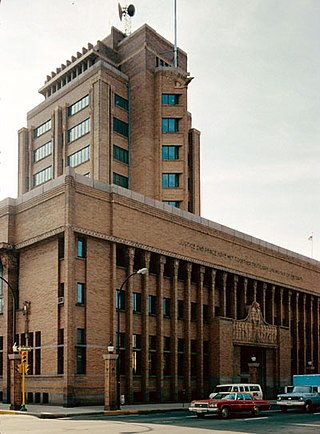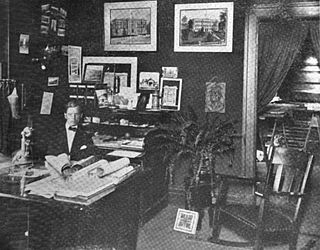Related Research Articles

The National Bank of Detroit (NBD), later renamed NBD Bank, was a bank that operated mostly in the Midwestern United States. Following its merger with First National Bank of Chicago, the bank was ultimately acquired and merged into Bank One, at which point the NBD name was discontinued. Today, what was once NBD is owned by JPMorgan Chase & Co.

William LaBarthe Steele was an American architect from Chicago, Illinois. He is considered a principal member of the Prairie School Architectural Movement during the early 20th century.
A weather beacon is a beacon that indicates the local weather forecast in a code of colored or flashing lights. Often, a short poem or jingle accompanies the code to make it easier to remember.
Purcell & Elmslie (P&E) was the most widely know iteration of a progressive American architectural practice. P&E was the second most commissioned firm of the Prairie School, after Frank Lloyd Wright. The firm in all iterations was active from 1907 to 1921, with their most famous work being done between 1913 and 1921.

Huntington Bancshares Incorporated is an American bank holding company headquartered in Columbus, Ohio. The company is ranked 521st on the Fortune 500, and is 26th on the list of largest banks in the United States.
Green & Wicks was an architectural firm of Buffalo, New York.

The Detroit Financial District is a United States historic district in downtown Detroit, Michigan. The district was listed on the U.S. National Register of Historic Places on December 14, 2009, and was announced as the featured listing in the National Park Service's weekly list of December 24, 2009.

Davenport Bank and Trust Company was for much of the 20th century the leading bank of the Quad Cities metropolitan area and the surrounding region of eastern Iowa and western Illinois. It was at one time Iowa's largest commercial bank, and the headquarters building has dominated the city's skyline since it was constructed in 1927 at the corner of Third and Main Streets in downtown Davenport, Iowa. It was acquired by Norwest Bank of Minneapolis in 1993 and now operates as part of Wells Fargo following a 1998 merger of the two financial institutions. The historic building was listed on the National Register of Historic Places in 1983 under the name of its predecessor financial institution American Commercial and Savings Bank. In 2016 the National Register approved a boundary increase with the Davenport Bank and Trust name. It was included as a contributing property in the Davenport Downtown Commercial Historic District in 2020. It remains the tallest building in the Quad Cities, and is today known as Davenport Bank Apartments as it has been redeveloped into a mixed-use facility housing commercial, office, and residential space.

Keene & Simpson was an American architectural firm based in Kansas City, Missouri, and in practice from 1909 until 1980. The named partners were architects Arthur Samuel Keene FAIA (1875–1966) and Leslie Butler Simpson AIA (1885–1961). In 1955 it became Keene & Simpson & Murphy with the addition of John Thomas Murphy FAIA (1913–1999), who managed the firm until his retirement in 1980.
Louis Berger & Co. was an architectural firm in Queens, New York active between 1895 and 1930. It was a major local architect of Ridgewood, Queens.

Lambert Packard (1832-1906) was an American architect from St. Johnsbury, Vermont.
Patton & Fisher was an architectural firm in Chicago, Illinois. It operated under that name from 1885 to 1899 and later operated under the names Patton, Fisher & Miller (1899–1901) and Patton & Miller (1901–1915). Several of its works are listed on the National Register of Historic Places.

Charles W. Bates (1879–1929) was an American architect who practiced primarily in Wheeling, West Virginia, and was one of the region's most successful architects. He mostly specialized in commercial and school buildings in the north Ohio River valley.

Cudworth & Woodworth, later Cudworth, Woodworth & Thompson and Cudworth & Thompson, was an architectural firm from Norwich, Connecticut.

J. Williams Beal, Sons, successor to the office of J. Williams Beal, was a successful architectural firm based in Boston, Massachusetts. Established in 1920 by the sons of the late architect Beal, it remained in business into the 1980s.
Frank Orlando Weary was an architect based in Akron, Ohio. He joined in the partnership Weary & Kramer with George W. Kramer. Weary designed the Carroll County Courthouse in Carrollton, Ohio in Second Empire style, which was recognized by listing on the National Register of Historic Places in 1974. He also designed the Akron Public Library (1904), a Carnegie library, also listed on the National Register. His brother Edwin D. Weary was also an architect, known for designing bank buildings in Chicago and partnering with W. H. Alford at Weary and Alford.

The Heritage Tower is a mixed-use commercial and residential building located at 25 West Michigan Avenue in Battle Creek, Michigan. It was originally built as the Old-Merchants National Bank and Trust Co. Building, and designed as an office building. It was listed on the National Register of Historic Places in 2018.

The Hotel on Phillips is a hotel at 100 N. Phillips Ave. in Sioux Falls, South Dakota. It is located in the former Sioux Falls National Bank building, a skyscraper built in 1917, during World War I. The building was listed on the National Register of Historic Places in 1979 as "Sioux Falls National Bank Building". The property has also been known as the 100 North Phillips Building.

Angus V. McIver was an American architect who designed many buildings in the state of Montana.
Otis Leonard Wheelock was an architect in upstate New York and Chicago. He and his wife had two adopted children, a son Harry B. Wheelock who was an architect and a daughter.
References
- 1 2 3 "The Bankers Magazine". Bradford Rhodes. February 5, 1919 – via Google Books.
- ↑ "Bankers Monthly". Hanover Publishers. February 5, 1920 – via Google Books.
- ↑ Finch, Will L. (February 5, 1917). "Town Development: A Magazine for the Man who Believes in Himself and in His Town" – via Google Books.
- ↑ "Bankers Monthly". Hanover Publishers. February 5, 1920 – via Google Books.
- ↑ Lane, Samuel Alanson (February 5, 1892). "Fifty Years and Over of Akron and Summit County [O.]". Beacon Job Department – via Google Books.
- 1 2 "Archival Image & Media Collection". digital-libraries.saic.edu.
- 1 2 3 4 "Weary and Alford – project list – Philadelphia Architects and Buildings". www.philadelphiabuildings.org.
- ↑ Thornton, Kurt (September 4, 2004). Battle Creek. Arcadia Publishing. ISBN 9780738533056 – via Google Books.